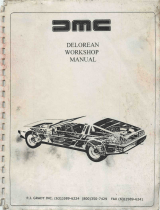
5
2. After performing check #1, drain all air pressure from the
brake system. Note that the fan is now engaged and
cannot be turned by hand. If it cannot be turned, proceed
to test #3. If it can be turned, the clutch is defective and
must be repaired or replaced.
3. Check the operation of the thermostatic control valve by
running the engine up to operating temperature. Note
that the fan clutch engages when engine temperature
rises to normal or above and disengages after fan
cooling is accomplished. Normal engagement time
should not exceed two minutes. If engagement time does
not exceed two minutes, proceed to check #4. If
engagement time does exceed two minutes:
A. If this test is being performed for the first time after
installation of the fan clutch, recheck the setting of
the thermostatic control valve and compare it with
the setting of the engine coolant thermostat or in the
case of vehicles with radiator shutters, with the
setting of the shutter control. The fan clutch control
should always be 10°F higher than the highest setting.
B. If the fan clutch installation has successfully passed
this test before, but does not do so now, the
thermostatic control valve or thermostat are defective
and should be replaced.
LEAKAGE CHECKS
In order to check for air leakage past the only two sliding
o-rings in the FD-L
™
fan clutch, it is necessary to disconnect
the single air control line.
Check for leakage by connecting a 90 cu. in. reservoir
(Bendix part number 225000) with a gauge installed to the
control port of the fan clutch. After filling the 90 cu. in.
reservoir with 100 psi, allow the pressure to stabilized and
observe the time required for the reservoir pressure to drop
to 90 psi. If the time required is less than 1 minute, leakage
is excessive and repair or replacement is necessary.
WARNING! PLEASE READ AND FOLLOW
THESE INSTRUCTIONS TO AVOID
PERSONAL INJURY OR DEATH:
When working on or around a vehicle, the following
general precautions should be observed at all times.
1. Park the vehicle on a level surface, apply the
parking brakes, and always block the wheels.
Always wear safety glasses.
2. Stop the engine and remove ignition key when
working under or around the vehicle. When
working in the engine compartment, the engine
should be shut off and the ignition key should be
removed. Where circumstances require that the
engine be in operation, EXTREME CAUTION should
be used to prevent personal injury resulting from
contact with moving, rotating, leaking, heated or
electrically charged components.
3. Do not attempt to install, remove, disassemble or
assemble a component until you have read and
thoroughly understand the recommended
procedures. Use only the proper tools and observe
all precautions pertaining to use of those tools.
4. If the work is being performed on the vehicle’s air
brake system, or any auxiliary pressurized air
systems, make certain to drain the air pressure from
all reservoirs before beginning ANY work on the
vehicle. If the vehicle is equipped with an AD-IS
™
air dryer system or a dryer reservoir module, be
sure to drain the purge reservoir.
5. Following the vehicle manufacturer’s
recommended procedures, deactivate the electrical
system in a manner that safely removes all
electrical power from the vehicle.
6. Never exceed manufacturer’s recommended
pressures.
7. Never connect or disconnect a hose or line
containing pressure; it may whip. Never remove a
component or plug unless you are certain all
system pressure has been depleted.
8. Use only genuine Bendix
®
replacement parts,
components and kits. Replacement hardware,
tubing, hose, fittings, etc. must be of equivalent
size, type and strength as original equipment and
be designed specifically for such applications and
systems.
9. Components with stripped threads or damaged
parts should be replaced rather than repaired. Do
not attempt repairs requiring machining or welding
unless specifically stated and approved by the
vehicle and component manufacturer.
10. Prior to returning the vehicle to service, make
certain all components and systems are restored
to their proper operating condition.
REMOVAL
It is recommended that the FD-L
™
fan clutch be removed
from the vehicle for service even though it is possible on
some installations to install kits 106733 and 106732 without
clutch removal.
1. Secure the vehicle on a level surface by means other
than the brakes.
2. Drain ALL reservoirs to 0 psi (0 kPa) air pressure.
3. Disconnect the air line from the fan clutch.
4. Remove the six cap screws and lockwashers that attach
the vehicle’s fan to the fan plate of the FD-L
™
fan clutch.









